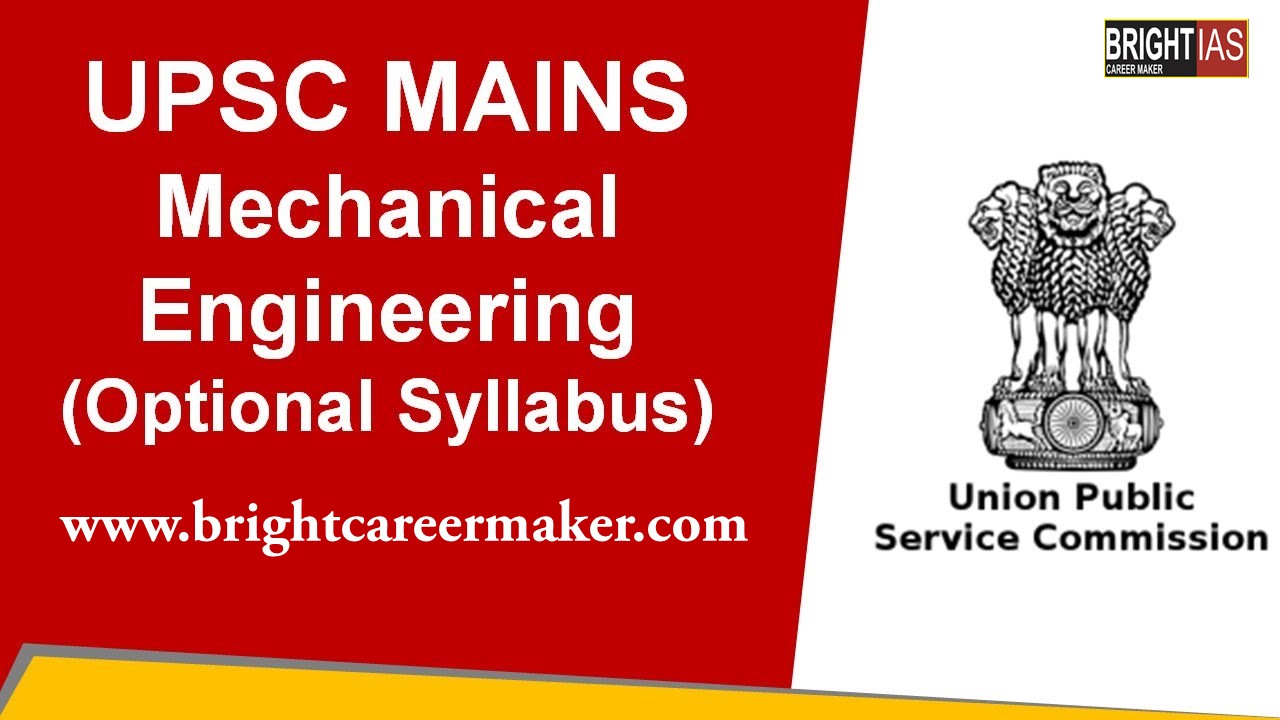
UPSC Mechanical Engineering Syllabus
Paper – I
1. Mechanics:
- Mechanics of
rigid bodies: Equations of equilibrium in space and its application; first
and second moments of area; simple problems on friction; kinematics of
particles for plane motion; elementary particle dynamics.
- Mechanics of
deformable bodies: Generalized Hooke’s law and its application; design
problems on axial stress, shear stress, and bearing stress; material
properties for dynamic loading; bending shear and stresses in beams; determination
of principle stresses and strains - analytical and graphical; compound and
combined stresses; bi-axial stresses - thin-walled pressure vessel;
material behavior and design factors for dynamic load; design of circular
shafts for bending and torsional load only; deflection of beam for
statically determinate problems; theories of failure.
2. Engineering Materials: Basic
concepts on structure of solids; common ferrous and non-ferrous materials and
their applications; heat-treatment of steels; non-metals- plastics, ceramics,
composite materials, and Nano-materials.
3. Theory of Machines: Kinematic
and dynamic analysis of plane mechanisms. Cams, Gears and epicyclic gear
trains, flywheels, governors, balancing of rigid rotors, balancing of single
and multicylinder engines, linear vibration analysis of mechanical systems
(single degree of freedom), Critical speeds, and whirling of shafts.
4. Manufacturing Science:
- Manufacturing
Process: Machine tool engineering – Merchant’s force analysis; Taylor’s
tool life equation; conventional machining; NC and CNC machining process;
jigs and fixtures. Non-conventional machining – EDM, ECM, ultrasonic,
water jet machining, etc.; application of lasers and plasmas; energy rate
calculations. Forming and welding processes- standard processes. Metrology
- the concept of fits and tolerances; tools and gauges; comparators;
inspection of length; position; profile and surface finish.
- Manufacturing
Management: System design: factory location- simple OR models; plant
layout - methods based; applications of engineering economic
analysis and break-even analysis for product selection, process
selection, and capacity planning; predetermined time standards. System
planning; forecasting methods based on regression and decomposition, design
and balancing of multi-model and stochastic assembly lines; inventory
management – probabilistic inventory models for order time and order
quantity determination; JIT systems; strategic sourcing; managing inter
plant logistics. System operations and control: Scheduling algorithms for
job shops; applications of statistical methods for product and process
quality control - applications of control charts for mean, range, percent
defective, number of defectives and defects per unit; quality cost
systems; management of resources, organizations, and risks in projects.
System improvement: Implementation of systems, such as total quality
management, developing and managing flexible, lean, and agile
organizations.
Paper-II
1. Thermodynamics, Gas Dynamics, and Turbine:
- The basic concept
of First –law and second law of Thermodynamics; the concept of entropy and
reversibility; availability and unavailability and irreversibility.
- Classification
and properties of fluids; incompressible and compressible fluids flows;
effect of Mach number and compressibility; continuity momentum and energy
equations; normal and oblique shocks; one-dimensional isentropic flow;
flow or fluids in duct with frictions that transfer.
- Flow-through
fans, blowers, and compressors; axial and centrifugal flow configuration;
design of fans and compressors; single problems compresses and turbine
cascade; open and closed cycle gas turbines; work done in the gas turbine;
reheat and regenerators.
2. Heat Transfer:
- Conduction
heat transfer- general conduction equation - Laplace, Poisson and Fourier
equations; Fourier law of conduction; one-dimensional steady-state heat
conduction applied to a simple wall, solid and hollow cylinder &
spheres.
- Convection
heat transfer- Newton’s law of convection; free and forces convection; heat
transfer during the laminar and turbulent flow of an incompressible fluid over
a flat plate; concepts of Nusselt number, hydrodynamic and thermal
boundary layer their thickness; Prandtl number; analogy between heat and
momentum transfer- Reynolds, Colbum, Prandtl analogies; heat transfer
during laminar and turbulent flow through horizontal tubes; free
convection from horizontal and vertical plates.
- Black body
radiation - basic radiation laws such as Stefan-Boltzmann, Planck
distribution, Wein’s displacement, etc.
- Basic heat
exchanger analysis; classification of heat exchangers.
3. I.C. Engines:
- Classification,
thermodynamic cycles of operation; determination of break power, indicated
power, mechanical efficiency, heat balance sheet, interpretation of
performance characteristics, petrol, gas, and diesel engines.
- Combustion in
SI and CI engines, normal and abnormal combustion; effect of working
parameters on knocking, reduction of knocking; Forms of the combustion chamber for SI and CI engines; rating of fuels; additives;
emission.
- Different
systems of IC engines- fuels; lubricating; cooling and transmission
systems. Alternate fuels in IC engines.
4. Steam Engineering:
- Steam
generation- modified Rankine cycle analysis; Modern steam boilers; steam
at critical and supercritical pressures; draught equipment; natural and
artificial draught; boiler fuels solid, liquid, and gaseous fuels. Steam
turbines - principle; types; compounding; impulse and reaction turbines;
axial thrust.
- Steam
nozzles- a flow of steam in the convergent and divergent nozzle; pressure at
throat for maximum discharge with different initial steam conditions such
as wet,
a saturated and superheated, effect of variation of back pressure; a supersaturated flow of steam in nozzles, Wilson line. - Rankine cycle
with internal and external irreversibility; reheat factor; reheating and
regeneration, methods of governing; back pressure and pass out turbines.
- Steam power
plants - combined cycle power generation; heat recovery steam generators
(HRSG) fired and unfired, cogeneration plants.
5. Refrigeration and air-conditioning:
- Vapour
compression refrigeration cycle - cycle on p-H & T-s diagrams;
eco-friendly refrigerants - R134a,123; Systems like evaporators,
condensers, compressor, expansion devices. Simple vapor absorption
systems.
- Psychometric
- properties; processes; charts; sensible heating and cooling;
humidification and dehumidification effective temperature;
air-conditioning load calculation; simple duct design.



Comments on “UPSC Mechanical Engineering Syllabus”